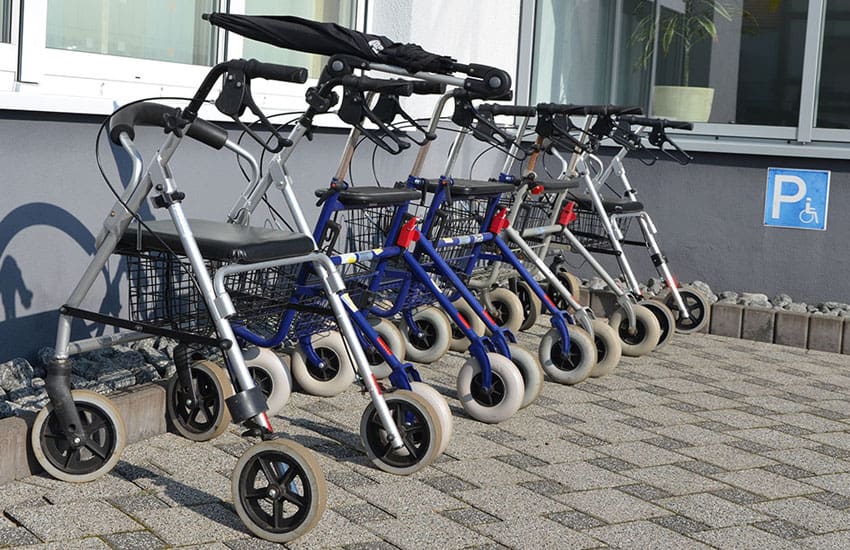Advice for assistive tech manufacturers on what information to give to procurement teams
The World Health Organization’s (WHO) latest global assistive technology guide includes important guidance on what details assistive technology manufacturers should give to procurement teams.
This information could be useful for manufacturers of mobility, independent living and rehabilitation products when thinking about what details to give to procurement teams to ensure effective provision of devices and services.
The guide contains specifications for 26 prioritised assistive products and describes the minimum quality requirements for manufacturing. Products include crutches, grab rails, manual wheelchairs, hearing aids and white canes.
Alongside product-specific information in the document, WHO has provided some general advice for procurement teams on developing procurement specifications.
Below, THIIS has detailed the key takeaways for assistive technology manufacturers on what details to give to procurement teams, including certificates of conformity, repairing, product dimensions and spare parts, to help develop strong procurement specifications.
Product description
Procurement teams should clearly describe the assistive product, intended use and what it should be able to do. This description of the product’s general features should give enough detail to identify the product’s function and characteristics, but also be generic and not biased towards a brand or design.
WHO says that a general specification encourages competition and gives suppliers the opportunity to offer innovative assistive products that may be new to the market.
The UK Government is currently consulting on plans to overhaul procurement rules in the UK. As part of these plans, the government is looking to make the procurement process easier for smaller businesses to win government contracts, with an aim of driving local growth and promoting innovation.
Quality and safety
Suppliers should provide a certificate to procurement teams that clearly states the product complies with the terms of the procurement specification (which should reflect applicable regulations and standards) and state that it is safe and effective for the intended use. The certificate should be signed by an authorised representative of the supplier.
A certificate or declaration of conformity is a legal document signed by the supplier that confirms a product conforms to applicable national or international regulations in the country where it is procured.
If products do not comply or are not tested according to relevant standards, or if they deviate from the procurement specification, the supplier should provide an explanation to the procurement team, WHO highlights.
Additional product requirements
The procurement specification can also describe which measurements to use and how measurements should be taken to avoid misunderstandings and ensure all suppliers provide measurements in the same way so they can be compared, the guide states.
For products with changeable sizes, such as folding mobility scooters, it is useful to have the dimensions in different modes for transportation or storage – this is something for suppliers to be aware of when providing dimensions. Overall weight and dimensions of the product in its operation mode and in transportation (with packaging) should be required. Wherever applicable, additional measurements can be specified.
The guide continues that suppliers should supply information for service providers about how to select, assemble, fit and adapt the assistive product. Where applicable, they should also provide maintenance, repairing and refurbishing instructions.
“Instructions for use for users and caregivers should be required,” the guide further outlines. “These should be supplied with each product in the form of a product user manual. Instructions usually include how to use, maintain and clean the assistive product safely and effectively.”
Suppliers should further disclose warranty details, including the accessories and spare parts included with the product. It adds that assistive device suppliers should be required to repair any broken parts of the assistive device during the warranty period, without expense to the user.
Maintenance, repair and refurbishing
WHO states: “Regular maintenance, repair and refurbishing are essential to prolong the life of assistive products.”
This is an area for assistive technology manufacturers to consider as in certain circumstances, procurement teams might ask for information about maintenance, repairs and refurbishing.
The guide continues that these services should be detailed in the procurement specification for product manufacturers or suppliers where feasible and cost-effective. This is particularly important for complex rehabilitation devices where skilled staff are needed to carry out the work.
Moreover, the procurement team should identify the need for services and define the scope of what is to be provided by suppliers, including the timeframe and frequency, and require suppliers to provide a cost estimate in the bidding. This could include details of payment (per hour), travel expenses (e.g. fuel charges, hotel bills), rules to cover several services completed on the same route, and cost of spare parts (if not covered under warranty).
“Suppliers must indicate how these services will be provided,” the guide continues. “If services are to be subcontracted, they must provide information on the subcontractor, including terms and conditions.”
Assistive device training
Additionally, assistive technology suppliers can play a role in training service providers and this requirement should be included in the supplier’s contract, especially for complex products, WHO advises.
The scope of training should be clearly defined in the procurement specification and may include training on assessment and selection, fitting, adjustments and adaptations, user training, and maintenance, repair and refurbishment.
User training on use and care of assistive products should be given by local service providers. However, if this is not possible, the procurement specification may request suppliers to include user training as part of their bids.
The supplier should also be required to provide a product user manual, giving clear instructions on using and maintaining the product.
Environmental impact
WHO also recommends: “Suppliers should consider whether a product is biodegradable or whether there is potential for recycling at the end of its use. When products reach the end of their lifespan, disposal must be safe and effective.”




